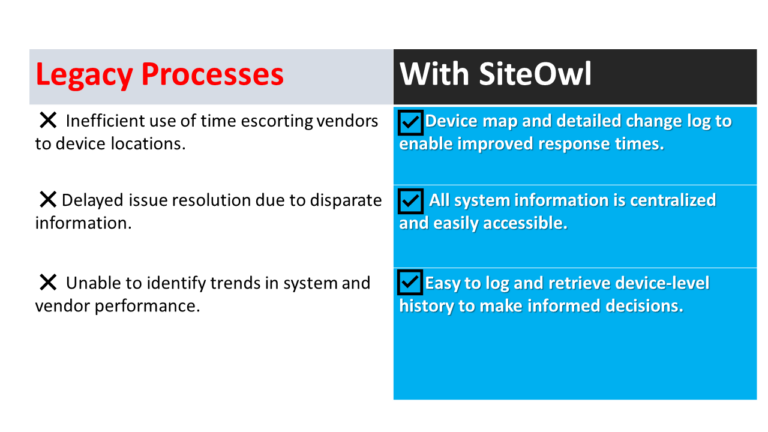Table of Contents
- Spreadsheets lack visual insights
- Spreadsheets are not purpose-built for security
- Spreadsheets don’t scale well
- Don’t automatically update as the system grows
- No visual proof = No confidence
- Physical security happens in real-time
Did you know that physical security breaches can be just as devastating to your business as cyber breaches? Based on data from the U.S. Department of Energy, physical attacks on the grid rose 77% in 2022. So if criminals are bold enough to target government infrastructure, how much more vulnerable are private businesses?
Here’s the thing: Physical security is the foundation of any cyber defense. Because cyber security is only as good as its weakest link, it’s important to ensure your physical security measures are as strong as your cyber defenses.
The challenge with managing physical security systems is that many of the tools you use are just not designed for the task.
Specifically, many security teams rely on spreadsheets for managing their physical security systems. According to a survey conducted by the SANS Institute, over half of the manufacturers polled (65%) said they use spreadsheets to manage their physical security systems.
Don’t get me wrong: We love spreadsheets; they’re practical, easy to use and they’re a go-to tool for countless teams and companies. But are they actually the best tool for designing, managing, and maintaining your physical security systems?
Research indicates that users spend on average 12 hours per month(that’s one-and-a-half eight-hour work days!) updating, revising, consolidating, modifying, and correcting spreadsheets. Is that what you want your security team to be doing?
Here are six pitfalls of using spreadsheets to manage your physical security systems and what to do instead.
1. Spreadsheets lack visual insights
Many security teams resort to utilizing spreadsheets, which are inherently lacking in their ability to meet the unique demands of physical security management. Due to their tabular format, spreadsheets fail to offer a comprehensive visual representation of devices on a floor plan. As a result, it becomes increasingly difficult to effectively manage and monitor their security infrastructure, highlighting the need for better-suited tools designed specifically for this task.
What’s a better tool for managing your security infrastructure?
One effective solution for managing your security infrastructure is a dedicated lifecycle management platform that enables you to manage all aspects of your physical security system in a centralized location.
SiteOwl is built specifically for physical security management, offering advanced features like map-based visualizations, comprehensive system dashboards, and real-time visibility for increased operational efficiency and overall security effectiveness.
2. Spreadsheets are not purpose-built for security
Consistent security system practices
Implementing consistent and scalable security system practices is crucial for organizations looking to adapt to ever-changing security challenges. With SiteOwl, you can establish a standardized framework that caters to your organization’s unique security needs and seamlessly accommodates future growth.
3. Spreadsheets don’t scale well
Security teams often start with a spreadsheet to manage their physical security systems. A spreadsheet for video surveillance, a spreadsheet for access control readers, one for badge printers, and the list goes on until they realize what they cannot obtain from a spreadsheet.
Spreadsheets are not designed to be the central system of record for enterprise security systems. Even if you’re an Excel wizard, you can only do so much when it comes to managing complex security systems efficiently.
But there’s a better way.
Rapidly Capture Asset Information with SiteOwl
- Warranty Dates
- Part Numbers
- MAC addresses
- IP Address
4. Don’t automatically update as the system grows
The physical security industry is experiencing a huge digital disruption, and to be successful, you need to understand how to leverage the power of technology. Maintaining the status quo will only increase security risks and expose your organization to greater vulnerabilities.
Not to get overly technical, but here’s the challenge with spreadsheets: It comes down to being able to trust the data you’re looking at, and the limited data structure of spreadsheets means that multiple copies of data are inevitable.
Spreadsheets are great for many things, but when it comes to tracking security projects, service, and installation quality, you will quickly see the benefits of a centralized platform that can deliver:
- Robust real-time reporting to facilitate coordination, commissioning, and programming.
- Centralized system of record with auditing, warranty, and lifecycle management.
- Vendor compliance with site-specific requirements for vendor performance.
SiteOwl makes it easy to stay up to date…
Information is the lifeblood of modern physical security systems, and with accurate data, you can avoid ending up with a lot of wasted time and money.
5. No visual proof = No confidence
It’s 9:00 am, and you go over to check on your cameras and notice that the same card readers working yesterday aren’t working today. Additionally, two security cameras are down, which means your security guards can’t see what’s happening in the parking lot. What went wrong?
Sequence of events:
- A security team member identified the access card readers as out of service and reported the issue. Another team member added the note about the cameras being out of position and notified your security integrator. This happened totally by chance and not due to any sort of planned maintenance.
- Integrator’s turnaround time to get the readers and cameras back up and running was 4 hours.
- Once onsite. You have to assign someone to escort the integrator to the site of the down devices, pulling the team member away from other important tasks.
- Integrator begins to work on the cameras, and you proceed to the next item on your list.
Then the next day arrives, and you realize the card readers aren’t working still. But you have no way of verifying what the integrator did. . Your spreadsheets are not giving you the complete picture, and you have no idea where to start.
SiteOwl provides a viable alternative
6. Physical security happens in real-time
Spreadsheets are not ideal for managing physical security systems primarily because they cannot provide real-time visibility into system status. In today’s fast-paced environment, having immediate access to information is critical to identifying, analyzing, and addressing potential vulnerabilities or malfunctions in security systems. A delayed response can result in substantial downtime and increased risks.
Downtime is costly
The average cost of downtime is significant. Each minute costs an average of $9,000, according to the Ponemon Institute, bringing the downtime cost per hour to over $500,000.
- 43% of organizations experienced data loss as a result of outages.
- Over 30% of outages resulted in a direct revenue loss.
By employing a robust and innovative lifecycle platform, security teams can enjoy comprehensive, real-time monitoring to enhance overall performance and efficiency.
Conclusion
When selecting an enterprise lifecycle management platform for your physical security infrastructure, your goal is to maximize the value of your security investment while minimizing the time and effort required to manage it. That means finding a solution that is easy to use and provides the features you need to thrive in today’s security environment. The bottom line is that while spreadsheets are tremendously helpful for administrative tasks, managing physical security systems requires far more.
Spreadsheets are simply not designed to handle the complexity of today’s physical security environment or the workflow required to manage the lifecycle of an enterprise-wide security infrastructure. They are not purpose-built for security, and the features they do have often are limited.
There’s a better way to manage your physical security infrastructure, and as the industry’s first purpose-built enterprise lifecycle management platform SiteOwl is here to help you.
It’s time to go beyond spreadsheets and into the world of purpose-built enterprise lifecycle management.

Su Subburaj
Su is SiteOwl's CMO and leads all marketing and communications. Su has extensive strategy and management consulting experience and previously consulted for 3Sixty Integrated where she gained an in-depth understanding of digital transformation challenges in the physical security industry. When not working on strategies to expand SiteOwl's footprint, Su enjoys bad karaoke, weightlifting and traveling.





